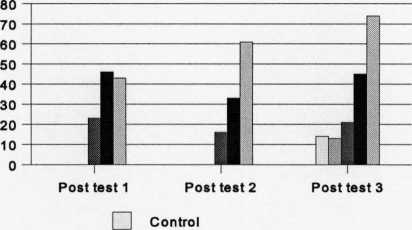1) was found for the Lexical contrast group (Wilcoxon: Z=2.03, p<.05) and the Definition
groups (Wilcoxon: Z=2.5, p<.05).
Does the children ,s prior knowledge of the lexical items influence the provision of semantic
properties?
No significant differences were found by the children’s prior knowledge of the lexical items.
Is the provision of semantic properties influenced by the semantic domain of the lexical
items?
No significant differences were found by the semantic domain of the lexical items.
Reference to the target word
During their story-tellings children referred to the target word in different ways. Each group
could score a maximum of 104. The groups varied in their reference to the target words as
the figure 7.35 shows.
Figure 7.35 Total number of reference to the target words by group across testing

[7] Phonological control
H Ostensive definition
U'*∣ Lexical contrast
[~~∣ Definition
As the previous figure shows the Definition and the Lexical contrast groups referred to the
target words more than the other groups across testing. During post test 1, the Lexical
contrast group referred to the target word significantly more times than the Ostensive
definition group (Wilcoxon: Z=2.04, p<.05). Significant differences were found during post
test 2 (Kruskall-Wallis I-Way Anova: X2 = 13.6, df = 2, p<.005) and post test 3 (Kruskall-
Wallis I-Way Anova: X2 = 32.6, df=4, p<.0000). Particularly, during post test 2 the
Definition group referred to the target words significantly more times than the Ostensive
273
More intriguing information
1. The name is absent2. The name is absent
3. The name is absent
4. The name is absent
5. The Advantage of Cooperatives under Asymmetric Cost Information
6. AN ECONOMIC EVALUATION OF THE COLORADO RIVER BASIN SALINITY CONTROL PROGRAM
7. The name is absent
8. The name is absent
9. The name is absent
10. The name is absent